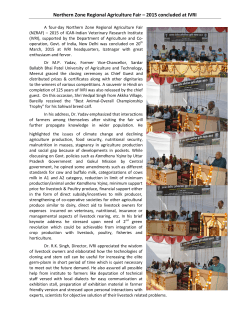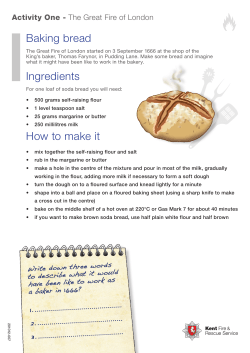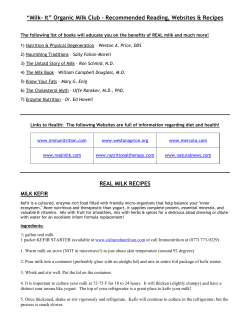
Document 203466
Contribution of Livestock to National Economy & How to Improve It further By Dr. Muhammad Zulfiqar DVM (Gold Medal),M.Sc,PhD (USA) Director General (Research) L&DD Department Punjab Directorate General of Research Veterinary Research Institute (VRI) Lahore Livestock Production research Institute (LPRI) Okara Poultry Research Institute (PRI) Rawalpindi Foot and Mouth Disease Research Center Lahore Contribution 11 % GDP 49 % Agriculture Around 10 % of national export Milk alone gets more income to farmers than rice and cotton or sugarcane and wheat Major security for farmers 30-35 million landless farmers Livestock Population (Millions) 2000 2005 2010 2015 2020 Buffalo 22.004 26.300 30.300 35.300 41.300 (57%) Cattle 22.669 24.200 26.700 30.200 34.700 (43%) Goat 47.426 56.700 66.700 79.200 93.200 (64%) Sheep 24.084 24.900 25.900 27.100 28.65 (15%) Animal Products (Million Metric Tons) Milk 25.566 29.474 33.400 38.400 44.200 (50%) Meat 1.695 1.972 2.272 2.632 3.422 (53%) 204.465 227.395 (41%) Human Population (Million) Pakistan 142.654 161.151 191.753 The livestock revolution Most future job opportunities are going to be in the self employment sub sector Most jobs are going to be in the “on farm sector” Livestock as part of the on farm sector offers the future potential z Provided we look at the livestock sector afresh Cont…. Cont…. Look at the end products rather than dairy, and small ruminants….e.g. z Milk and milk products z Meat and meat products Take a holistic look….from “fodder to the product” and address needs of the entire supply chain Strengths Highest level of commitment at political, policy and operational levels to mainstream Livestock. z MTDF (2005-10) on Livestock includes: z z z z Rural poverty alleviation through exploitation of livestock resources/potentials Fulfillment of increasing demand for livestock products Phasing out of import of milk and milk products Promotion of exports of livestock and livestock products Weakness Higher numbers with poor genetic makeup of majority of the stock High post harvest losses due to inadequate collection facilities from remote areas; Outdated and limited marketing facilities along with prevailing consumer-oriented price controls; Limited access to credit; Risk averse MFIs Cont… Cont… Weak mechanism of price regulation to check wide variation of prices at producers and consumer levels; Inadequate quantity and poor quality of feed and fodder; Limited animal health coverage; and Weaknesses covering planning, production technology transfer and policy development Health Disease Diagnosis Clinical z Microscopy z Animal Cell Culture z Limited Elisa z Diagnostic Antigens z TB, Brucellosis, Mallein Diseases of Public Health Importance Cont… Cont… Vaccination z Killed Bacteriological Vaccines z z Live Bacterial Vaccines z z Anthrax, Mycoplasma Attenuated Viral Vaccines z z z HS; BQ: Enterotoxemia ND. Sheep & Goat Pox, Fowl Pox, PPR, Rabies Killed Viral Vaccines z FMD Vaccine Major Achievement Rinderpest Eradication from Pakistan Future Strategies z Development of rapid diagnostic kits z Using molecular techniques z Sequencing of pathogens z Epitope mapping to determine variation within strains z Fermentor Technology Cont… Cont… z Suspension Culture z Vaccination through feed/grains z Adopting methodologies to determine better immunogen strains z Expressing better immunogen (capsule) in bacteria etc z Development of recombinant vectors for vaccine delivery Nutrition z Fodder 30% Short z Concentrates – Cotton Seed Cake z Commercial feed – Early Stage Future Strategies z Introducing better varieties of fodder z Genetic engineering z Preservation during excess production Cont… Cont… z To develop feed production technologies which can improve the utilization of relatively low cost byproducts and tropically adapted plant species z Enzymes of microbial additives z Growth promoters & regulators z Manipulation of rumen ecosystem z Milk replacer z Avoiding rumen bombardment Breeding & Genetics z Artificial Insemination z Embryo Transfer (limited) Future Strategies z Buffalo major milk producer least studied z Buffalo Research Institute, being Established z Hormonal Studies Cont… Cont… z Detection of silent heat z Chromosomal studies with reference to milk production z Mass production of in vitro sexed embryos, using new reproductive technologies and DNA technologies z Improvement of reproductive techniques Conclusion Development of core competency of scientists in any R&D system to address the issue of low productivity of livestock populations Establishment of equipped laboratories A strong nucleus of trained manpower in the leading edge technology and key areas in accelerating progress in animal health, production and biotechnology in the new millennium Cont… Cont… Strengthening R&D activities in animal biotechnology will enable the Pakistan’s livestock, poultry and fish industries to achieve high production efficiency at minimal cost and face the future challenges of a more market oriented and global trading environment Strong linkages between sister organizations Interactions with international animal biotechnology experts Identify research leaders in critical areas to form and lead research teams THANK YOU Role of Livestock in the Economy 2003-04 11.4% 47 53 88.6% GDP Livestock Agriculture Livestock Role of Livestock in the Economy Contribution in Agricultural GDP 47 % Contribution in National GDP 11 % Contribution in Exports 12 % Pop. dependent on Livestock 60 % LIVESTOCK POPULATION TRENDS 50000 POPULATION (000) 40000 Cattle 30000 Buffaloes Sheep 20000 Goats 10000 0 1950 1960 1970 1980 CENSUS YEAR 1990 2000 Demand & Supply of Livestock Products ‘000 TONS 2003-04 Product Demand Supply Gap % Surplus/(deficit) Mutton 820 723 (97) (13)% Beef 999 1,087 88 8% Chicken 279 378 99 35% Eggs 6,838 8,102 1,264 18% Milk 15,044 28,624 13,580 90% Demand is increasing @ 6-7 % per annum; whereas the supply is increasing @ 3.2 % per annum, creating a gap of around 3.8 % per annum. Demand side…..The Livestock Revolution Population Growth; Urbanization; Income Growth; z z are all fuelling a massive increase in demand of food of animal origin and rapid industrialization is increasing demand for livestock products such as wool, bones, hides and skins. It is therefore not inappropriate to use the term “Livestock Revolution” to describe the course of these events in Pakistan over next 20 years. MEAT PRODUCTION TRENDS 1100 23% 1000 000 MT. TONNES 900 800 700 -5% 600 225% 500 400 300 200 100 YEARS BEEF MUTTON POULTRY SWOT ANALYSIS Livestock Typical small dairy farm, Pakistan Vs India Pakistan India Farm size (# animals) Land Holdings 1 2 0 0 Milk Yield (Kg) 1,417 1,058 68% 46% 65% 51% $ 0 58 $ 0 96 Home consumption Off farm income Per capita 6,000 Poor Hhds SocialMobilization Mobilization Social Organizing poorest Organizing poorest Households Households Savings Savings Training COManagers Managers Training CO Identification Training Identification &&Training Of Chilling unit Of Chilling unit operators operators Capacitybuilding building Capacity Training Training Extension services Extension services ….PPPP Milk Milk Collection Collection system system Farms Land development Rehab of infrastructure Breed improvement Research on animal production & Health traits Processing Units (Milk; Meat; & Feed mills) On Job farmers training MicroFinance Finance Micro For For Purchaseof ofanimals animals&& Purchase Feed/fodder Feed/fodder Repaymentininkind kind Repayment through through purchaseof of purchase milk/animals milk/animals bythe thefarm farm by NRSP/ GOPb Chilling units units Chilling Ops&& Ops Maintenance Maintenance
© Copyright 2025





















